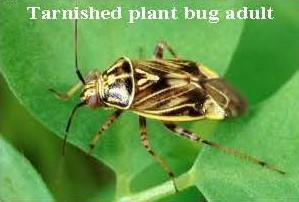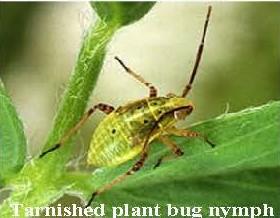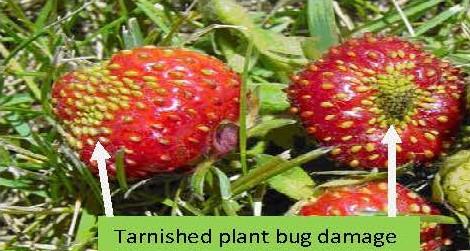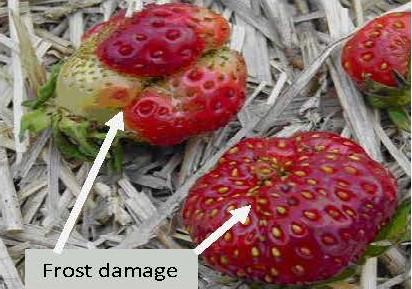The feeding by Tarnished plant bugs is one of the causes of irregularly-shaped, catfaced strawberries. The insects damage fruit by puncturing and then sucking the contents of individual seeds; which stops development of the berry in the area surrounding the feeding site. Tan-brown seeds that are large and hollow are an indication of TPB damage. If you see deformed fruit in the field, you should inspect the fruit to see if the damage is due to tarnished plant bug or frost. Frost often kills or deforms the king berries, leaving the secondary berries with little or no damage. Tarnished plant bugs usually cause little damage to the king berry, while destroying secondary blooms. When trying to make a distinction between frost and tarnished plant bug damage you should examine the entire cluster. With frost damage, healthy and damaged fruit are on the same cluster. With tarnished plant bug damage, the entire cluster is usually damaged. Tarnished plant bugs usually damage the tip of the berry first, giving the berry the characteristic ‘seedy end’. Most of the time customers will not notice minor tarnished plant bug damage. With frost damage, any side of the berry can be deformed. If the sides of the fruit are damaged, and the tip is not seedy, you have frost damage. Quite often, with frost damage, you will see a suture mark between the normal and deformed sides of the berry.
Field scouting involves shaking several (10-15) selected flower clusters sampled from across a field over a piece of white cardboard to dislodge nymphs. If one nymph per cluster is found treatment is recommended. Tarnished plant bug adult Tarnished plant bug nymph Tarnished plant bug damage Frost damage
Chemical control: Brigade, Thionex, Danitol, or a combination of Brigade and Rimon (Brigade will control the adults while Rimon will disrupt the cuticle formation of the larvae) will reduce TPB damage.
Cultural control: Control weeds along roadways, ditches, and field borders to help prevent spring buildup of TPBs. Overwintered TPBs lay eggs in weeds in February and March that hatch in late March or early April. Weed control should be done in April while TPBs are still nymphs. Once adults are present on weeds or crimson clover, they will migrate into strawberries when the weeds/clover are removed. To avoid adult migration in spring, mow or disc under cover crops, especially legumes, before they flower and while TPBs are still in the nymphal stages.
Biological control: There are several predators that feed on the immature stages of TPB. These include bigeyed bugs, damsel bugs, minute pirate bugs and several species of spiders. These natural enemies will help reduce overall TPB populations.
Print Article
Return to Vegetable Insect IPM
 English
English العربية
العربية Български
Български 简体中文
简体中文 繁體中文
繁體中文 Hrvatski
Hrvatski Čeština
Čeština Dansk
Dansk Nederlands
Nederlands Suomi
Suomi Français
Français Deutsch
Deutsch Ελληνικά
Ελληνικά हिन्दी
हिन्दी Italiano
Italiano 日本語
日本語 한국어
한국어 Norsk bokmål
Norsk bokmål Polski
Polski Português
Português Română
Română Русский
Русский Español
Español Svenska
Svenska Català
Català Filipino
Filipino עִבְרִית
עִבְרִית Bahasa Indonesia
Bahasa Indonesia Latviešu valoda
Latviešu valoda Lietuvių kalba
Lietuvių kalba Српски језик
Српски језик Slovenčina
Slovenčina Slovenščina
Slovenščina Українська
Українська Tiếng Việt
Tiếng Việt Shqip
Shqip Eesti
Eesti Galego
Galego Magyar
Magyar Maltese
Maltese ไทย
ไทย Türkçe
Türkçe فارسی
فارسی Afrikaans
Afrikaans Bahasa Melayu
Bahasa Melayu Kiswahili
Kiswahili Gaeilge
Gaeilge Cymraeg
Cymraeg Беларуская мова
Беларуская мова Íslenska
Íslenska Македонски јазик
Македонски јазик יידיש
יידיש Հայերեն
Հայերեն Azərbaycan dili
Azərbaycan dili Euskara
Euskara ქართული
ქართული Kreyol ayisyen
Kreyol ayisyen اردو
اردو বাংলা
বাংলা Bosanski
Bosanski Cebuano
Cebuano Esperanto
Esperanto ગુજરાતી
ગુજરાતી Harshen Hausa
Harshen Hausa Hmong
Hmong Igbo
Igbo Basa Jawa
Basa Jawa ಕನ್ನಡ
ಕನ್ನಡ ភាសាខ្មែរ
ភាសាខ្មែរ ພາສາລາວ
ພາສາລາວ Latin
Latin Te Reo Māori
Te Reo Māori मराठी
मराठी Монгол
Монгол नेपाली
नेपाली ਪੰਜਾਬੀ
ਪੰਜਾਬੀ Afsoomaali
Afsoomaali தமிழ்
தமிழ் తెలుగు
తెలుగు Yorùbá
Yorùbá Zulu
Zulu ဗမာစာ
ဗမာစာ Chichewa
Chichewa Қазақ тілі
Қазақ тілі Malagasy
Malagasy മലയാളം
മലയാളം සිංහල
සිංහල Sesotho
Sesotho Basa Sunda
Basa Sunda Тоҷикӣ
Тоҷикӣ O‘zbekcha
O‘zbekcha አማርኛ
አማርኛ Corsu
Corsu Ōlelo Hawaiʻi
Ōlelo Hawaiʻi كوردی
كوردی Кыргызча
Кыргызча Lëtzebuergesch
Lëtzebuergesch پښتو
پښتو Samoan
Samoan Gàidhlig
Gàidhlig Shona
Shona سنڌي
سنڌي Frysk
Frysk isiXhosa
isiXhosa


